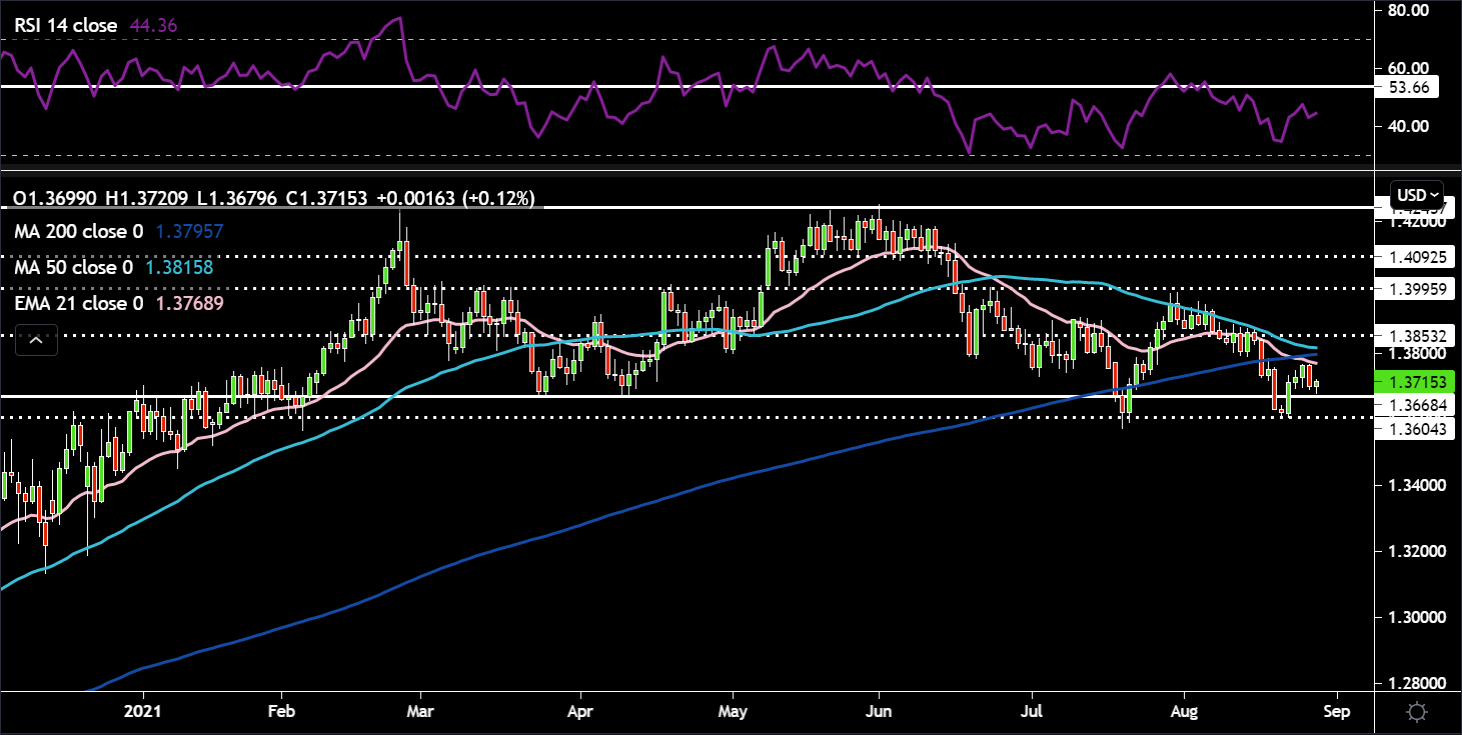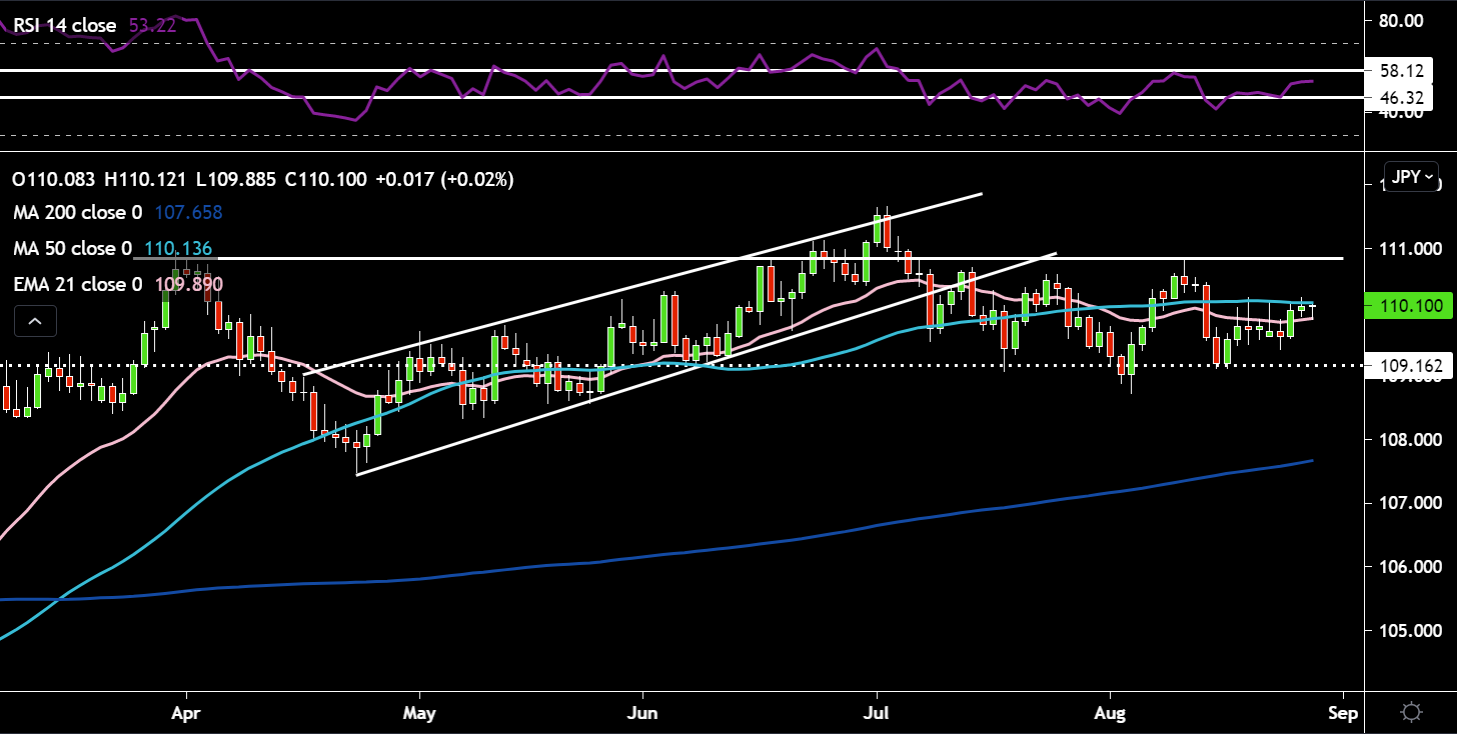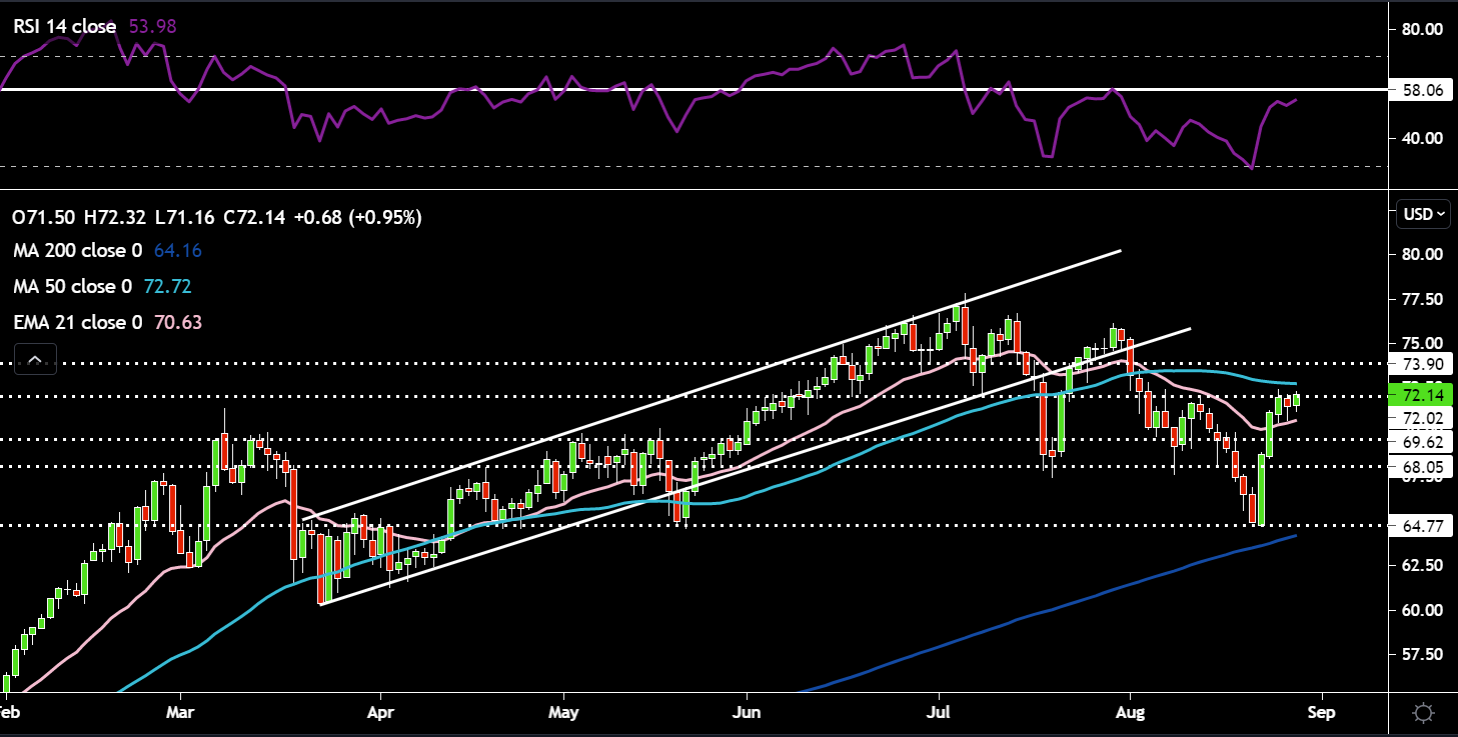- English
Dollar Index (DXY):
It’s been a fairly busy week stateside and we’re not even finished yet with Jackson Hole and the Fed’s preferred inflation metric – PCE index still to come. The beginning of the week, got off to a weak start with the much softer than expected PMI numbers, despite this the S&P rallied showing concerns over an imminent tapering were not present. Bond auction data at the short end of the curve was also interesting. The 2Y auction was very strong – indicating demand was not worried by a sell-off sparked by a hawkish surprise at Jackson Hole. Further out on the curve, the 5Y tenor was mediocre, but certainly not weak enough to signal jitters over what Powell may do tomorrow. QoQ Q2 GDP data was revised higher, but still under the 6.7% expected number. Jobless claims missed both on continuing claims and initial claims. Jackson Hole has already kicked off with a few Fed members speaking on the airwaves. Kansas City Fed President Esther George, stated the economy has reached the stage where the Fed can begin to easy off the monetary juice it has been delivering to the market. Bullard was his usual hawkish self, stating that he expects the Fed to end their bond purchases by Q1 2022, which seems about as likely as me starting ahead of Messi at PSG. The explosion in Kabul also caused a modest risk-off bid in the greenback as the VIX index shot up over 5%.
My expectations for Jackson Hole (Powell speaking at 3pm UK time) are that we see Powell take a neutral, balanced approach. He acknowledges both the strong employment gains as well as downside risks associated with Delta. Taper chatter will be on the light side and the Fed's George practically confirmed as such yesterday when she stated “communication in September meeting will reflect discussions on taper”. This would keep expectations on track for a December kick-off date for tapering. I think the change up to a virtual event indicates a shift in cautious sentiment as a result of covid fears. Powell is also not one who likes to rock the boat so we should see him err on the side of caution later today as a result. It does seem like a hawkish surprise from Jackson Hole appears less likely and the next topic of major relevance is going to be the U.S. labour market report next week Friday.
The dollar has managed to hold the 92.8 support level and is now just below the 93 round number. The 21-day EMA is providing some additional support for the dollar. The RSI is trying to reclaim the 55 level to complement bullish price action. The negative divergence trend on the RSI does need to be broken to see bullish momentum really get going. Targets on the upside would be the 31 March high around 93.5 and the 20 August high of 93.729. On the downside, the 50-day SMA should provide some support at 92.5. Below that 92 would be the next key downside level to monitor.
EURUSD:
The eurozone followed in the US’s footsteps with weak PMI numbers. Germany the largest economy in the eurozone, saw an upgrade to their final estimates for GDP growth figures (above expectations). Germany's Ifo business climate index weakened to 99.4 below expectations and lower than the previous months reading. This confirmed what we are seeing globally, that growth is losing steam. These softer numbers reflect a supply chain under pressure with bottlenecks in manufacturing and delta sapping confidence. The ECB’s de Guindos was bullish and signalled upgrades to the next macroeconomic projections. A change to the pace of PEPP purchases looks unlikely now with Chief Economist Lane out on the wires yesterday stating it was too early to discuss the end of PEPP at September policy meeting and that markets didn’t need long period of advance notice for the end of PEPP as it will continue in the form of APP. The forward guidance was the focus in the minutes out yesterday not tapering asset purchases. Given this I think the September meeting will be used to discuss the pace of purchases without any changes until agreement is reached (i.e. no change in pace at September meeting). Answers surrounding when PEPP will come to an end will likely be supplied at the December meeting. Given that financing conditions plays a pivotal role in the size of the balance sheet of the ECB, if the US gets through covid faster and the Fed starts getting hawkish then this could spillover and push up eurozone yields as we saw at the beginning of the year. The ECB would then feel it necessary to stick to current pace. Next week is a full data schedule for the single currency with inflation, unemployment, GDP growth, retail sales and final estimates for Markit PMIs dropping.

The EURUSD has been repeatedly capped by the 21-day EMA as price attempts to rally higher. The RSI 52 level is also having a similar effect, as price peaks here and rolls over. There is a bit of negative divergence keeping selling pressure in check as we test the lows around 1.166. If we see strength post Jackson Hole, I'd first see what price does around the 50-day SMA at 1.181, if that's breached then 1.185. On the downside, 1,17 support and the 20 August low at 1.166 would be areas of interest.
GBPUSD:
UK beat on the manufacturing side of its PMI numbers, but disappointed on the services side, which is important given 80% of the UK economy is services based. Supply chains are under pressure in the UK, as they are globally with many shelves missing certain products. Demand higher than supply is a good recipe for some decent inflation pickup. Besides this the UK data calendar has been very sparse with Cable ebbing and flowing in line with general risk sentiment. GBPUSD will take direction from Jackson Hole tomorrow as we move into the weekend. Next week is not very busy for Cable in terms of market moving events, but final estimates for Markit PMI numbers may cause some excitement.

A death cross is millimetres from taking place, which could affect the psychology of Cable traders. The 21-day EMA and 50-day SMA have been acting as dynamic resistance on price rallies. Add to that the resistance from the RSI at 53.66. The large range that started at the beginning of the year is still in place between 1.366 and 1.424. Right now we're at the bottom of that range. Upside targets would be the 200-day SMA at 1.38 and 1.385. On the downside 1.366 and 1.36 lows.
USDJPY:
This cross is one to watch given its high beta to US yield moves as we go into Jackson Hole. US 10-year yields have moved higher by around 10bps this week and are now right on their 50-day and 200-day SMA. A quick move higher could see USDJPY bid strongly into the weekend. However, a neutral approach by Powell should prevent a more aggressive sell-off in bond land. Core CPI data out from Japan overnight was stronger than expected.

USDJPY remains trapped between 109.162 and the 50-day SMA around 110.136. The RSI has maintained the 46.32 level, but will need to overcome the 58 zone for a breakout. On the upside my target would be 110.85 horizontal resistance. On the downside, the 109.162 should see buying interest return again.
AUDNZD:
The Antipodeans have both been a bit stronger against the dollar this week for differing reasons. The Aussie has had some reprieve as base metals like iron rebound and risk sentiment improved. Retail sales out overnight were weaker than expected, highlighting the drag from lockdowns. The Kiwi, had some solid NZ retail sales, but the serious kicker came from RBNZ assistant Governor Hawkesby who informed financial markets that a 50bps hike was discussed by the RBNZ at the last meeting, but was scrapped due to communication difficulties as opposed to economic risks. This cements the hawkish nature of the RBNZ with merely a pause instead of a rollback of their rate hike path. However, if delta spirals out of control then the RBNZ may need to adjust their hawkish outlook.
We saw a bearish candle breach the range support at 1.0418 on AUDNZD, but it looks like price is retracing back up to try reclaim the support level. Negative divergence is present on the RSI causing selling pressure to wane a bit. For now with price in this range 45 on the RSI looks like where price gains run into trouble. For now a range trade between 1.0418 and 1.04998 makes sense.
Gold:
The weaker dollar at the start of the week propped up the yellow metal. Then dollar strength reappeared with higher real rates (breached 1% mark now) to bring sellers back to the fray. The outcome of Jackson Hole on Friday could lead to some volatility for gold. Over the medium to longer term I feel there are a number of factors working against gold. Yield moves are skewed to the upside given the Fed and an economy which will return to normality. I do think 10-year yields are mispriced somewhat due to a variety of technical factors. Additionally, the dollar is in a very advantageous position as it benefits when risk sentiment takes a nosedive or when the Fed moves closer to tapering on strong economic data.

Gold has been trading in a very tight band between its 200-day SMA and 50-day SMA as traders await Jackson Hole. The RSI has also run into pressure at the 55 level. If gold likes Jackson Hole's outcome then the 200-day SMA at $1808 would be my first area of interest, above there the double top resistance at $1830 would pique my interest.
Oil:
The black liquid has seemed unstoppable until yesterday, with a move of over 10% off the $65 support level as the week got underway. The catalyst which sparked the initial large move was multi-faceted – 1) China reporting 0 covid cases (demand ramp up again) 2) Explosion at Pemex oil rig (lower supply) 3) Weaker dollar 4) Better risk sentiment. Looking past those factors the next drivers to have on your radar are – 1) The start of Hurricane season near the Gulf of Mexico could lead to potential supply destruction (Tropical Depression Nine could turn into a hurricane) 2) Summer travel season is fading and now with the EU considering reimposing travel restrictions on US which would hot jet fuel demand. Next week we will hear from the oil cartel OPEC+ again. Just in terms of a recap, OPEC+ is currently planning to raise output by 400k BPD every month beginning in August, until all the of 5.8mln BPD cuts are brough back to the market. The meeting comes at an interesting time as global growth rolls over, APAC struggles to contain delta growth and pressure from Biden to halt price increases. I think OPEC+ will feel far more comfortable with where oil is priced currently to add more supply to the market as planned.

Oil has hit a hurdle at $72 resistance with the 50-day SMA just above there at $72.74. It has had a great rally of the $65 support level. The 21-day EMA provides some price support currently. The RSI looks like its rolling over as it came very close to the 58 resistance. $74/75 would be my next upside target and on the downside $79 and $68 support would be key.
Bitcoin:
Bitcoin has had some positive news flow this week. Coinbase announced it will be buying more of the digital currency to add to its balance sheet. Paypal kept the positive news alive with the news it will allow UK customers to transact with crypto. Risk sentiment was also favourable for Bitcoin, however, despite all of this price has found resistance and pulled back. Maybe pre Jackson Hole repositioning?

Bitcoin ran into resistance at $49.2k (former range support). Currently, price is finding buyers at the 200-day SMA and 21-day EMA. The RSI is making negative divergence, feeding into slowing price appreciation. The RSI needs to try hold above the 57 line for the bullish trend to continue from here. Target on the upside would be $52.775k. On the downside $44k mini support and $41k former range resistance.
Ready to trade one of the many opportunities above? Start trading FX, Commodities and Cryptocurrency CFDs now
Related articles
Ready to trade?
It's quick and easy to get started. Apply in minutes with our simple application process.
The material provided here has not been prepared in accordance with legal requirements designed to promote the independence of investment research and as such is considered to be a marketing communication. Whilst it is not subject to any prohibition on dealing ahead of the dissemination of investment research we will not seek to take any advantage before providing it to our clients.
Pepperstone doesn’t represent that the material provided here is accurate, current or complete, and therefore shouldn’t be relied upon as such. The information, whether from a third party or not, isn’t to be considered as a recommendation; or an offer to buy or sell; or the solicitation of an offer to buy or sell any security, financial product or instrument; or to participate in any particular trading strategy. It does not take into account readers’ financial situation or investment objectives. We advise any readers of this content to seek their own advice. Without the approval of Pepperstone, reproduction or redistribution of this information isn’t permitted.
.jpg)

